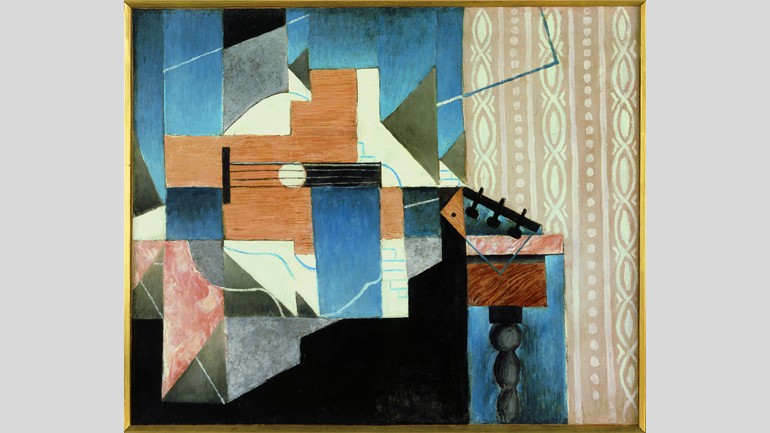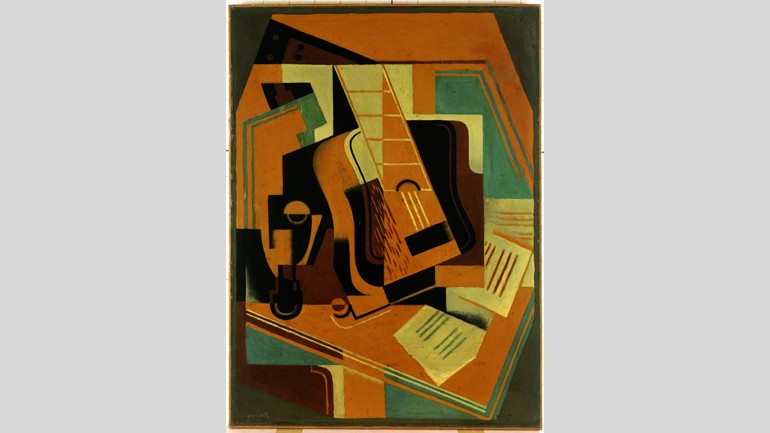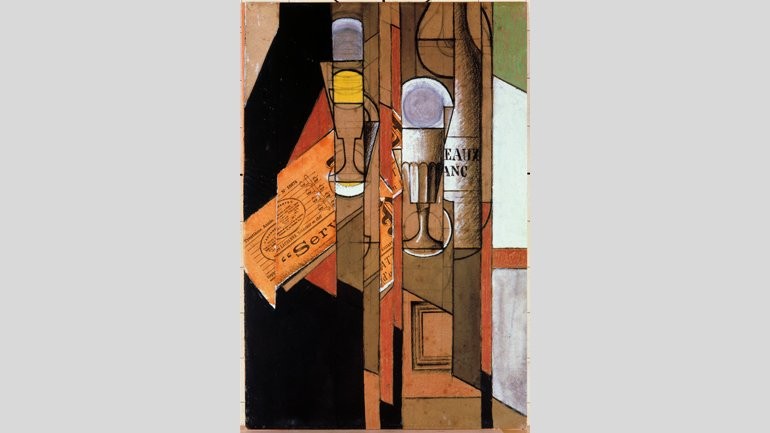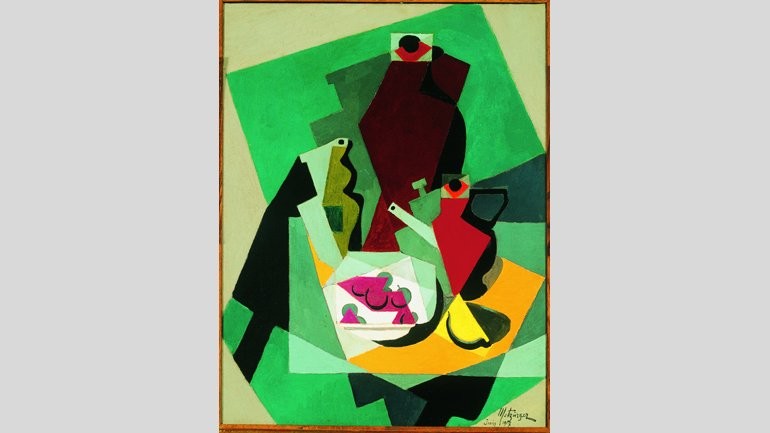Telefónica Collection
Cubism(s) and Experiences of Modernity
22 Nov 2017

La guitare sur la table [La guitarra sobre la mesa], 1913. Imagen, Cortesía de Fundación Telefónica © Fernando Maquieira

La guitare [La guitarra], 1918. Imagen, Cortesía de Fundación Telefónica © Fernando Maquieira

Verres, journal et bouteille de vin [Vasos, periódico y botella de vino], 1913. Imagen, Cortesía de Fundación Telefónica © Fernando Maquieira

Nature morte avec fruits et pitcher [Naturaleza muerta con fruta y jarra], 1917. © Jean Metzinger, VEGAP, Madrid, 2017. Imagen, Cortesía de Fundación Telefónica © Fernando Maquieira
Cubism(s) and Experiences of Modernity
22 November 2017 -
Curator: Eugenio Carmona
Organized by: Museo Nacional Centro de Arte Reina Sofía
Artists:
Manuel Ángeles Ortiz, Rafael Barradas (Rafael Pérez Giménez), María Blanchard (María Gutiérrez-Cueto Blanchard), Albert Gleizes, Juan Gris (José Victoriano González Pérez), Auguste Herbin, Vicente Huidobro, André Lhote, Jean Metzinger, Emilio Pettoruti, Vicente do Rego Monteiro, Xul Solar (Óscar Agustín Alejandro Schulz Solari), Joaquín Torres García, Georges Valmier, Daniel Vázquez Díaz
Jacques Lipchitz saw Cubism as a form of emancipation from all preceding artistic movements. Juan Gris believed that Cubism was not a manner but a state of mind, and that it was thus inescapably connected to every manifestation of contemporary thought. The protagonists of Cubism were well aware of the implications of their experience, and our present-day artistic consciousness unreservedly recognises Cubism as a cornerstone of modern art.
Even so, the various views and narratives of the cubist experience are sometimes at odds with each other. We speak of “cubism” in singular but its creative space was plural. It would be more accurate to talk of “cubisms”. One particular, and quite possibly dominant, view is inclined to take a restrictive approach to the artists, the times, and the settings of the cubist experience. However, there is another vision – one that is necessary right now –, which tends to be broad and complex, and which sees Cubism as a process that unfolded over time, with diverse inputs and numerous protagonists.
The union of the Telefónica Cubist Collection and the cubist holdings at Museo Nacional Centro de Arte Reina Sofia supports this plural conception of the cubist experience. The union of the two collections also brings the work of Juan Gris to the fore in both the exhibition and the narrative. Thinking about the cubist experience inevitably means thinking about the pervasiveness of the work of Picasso and Braque. But at this point in time, it is not only legitimate and possible to reconsider the cubist experience from the perspective of the formulations of Juan Gris, it is also desirable, because it means recognising the complexity of the true nature of Cubism.
Foundational Cubism. 1907-1914
In establishing and developing early Cubism, Picasso and Braque came up with solutions that emerged from a continuous, dynamic flow of work and regular and abundant exchange between the two artists. The terms “Analytical Cubism” and “Synthetic Cubism” have become widespread and are part of the vocabulary of Cubism. But they are not concepts or periods that Picasso and Braque themselves used or adopted as their own, and they do not define any specific artistic or aesthetic content. The terms “analytical” and “synthetic” are in fact part of the narratives developed by Daniel-Henry Kahnweiler based on the ideas of Juan Gris, and they were not generally in use in the practice of Cubism at the time.
In any case, Picasso and Braque’s cubist process, in its diversity, emerged from the meeting of primitivism and Cézanne-influenced post-Fauvism. It required the study of the essential formal and structural qualities of the picture. It defined “pure” painting in analytical or hermetic Cubism. But it also immediately challenged the two-dimensional purity of the canvas, introducing graphic, text, and iconographic signs, thereby inventing a new type of “verbal-visual” art. Taking this verbal-visual art further, Picasso and Braque paved the way for the conception of collage and the notion of sculpture or even painting as “object”. From this point, Picasso and Braque developed Cubism as a “language”, and Picasso even came up with iconographic and technical inventions that Guillaume Apollinaire readily described as “surréalistes”.
According to the formalist view of Cubism, there is an apparent or supposed logic of continuity between the development of “pure” painting and the invention of collage. But from the perspective of our aesthetic sensibility today, collage appears to be a significant change in the conception of art, contrary to the meaning of painting itself. In other words, Picasso and Braque’s cubist experience also had room for diversity and antinomy.
This notion of diversity and plurality is what motivates us to recover the “cubists’ Cubism”. Albert Gleizes, Jean Metzinger, and the early Auguste Herbin were not received without controversy by critics and museums. But it is now possible as well as desirable to reinstate these artists with the understanding that the work they carried out between 1909 and 1915 marked the shift from the legacy of Symbolism to a new, figurative system based on the dominance of form and the dynamic assembly of planes and figures. And that they sought to express the experience of the constant flow of everyday life and the “unanimous” relationship between subject and world.
Cubism was also able to find other ways to refract and give rise to “isms” that branched off but still preserved the enduring traces and the hallmark of Cubism. The transformations of Cubism developed by Fernand Léger and by Robert and Sonia Delaunay are widely known. Léger’s work, perhaps in line with Kahnweiler’s interests, has always been considered to fall within what is known as “essential” Cubism. The style developed by the Delaunays, on the other hand, was given its own name, Orphism, by the poet Guillaume Apollinaire, based on the principle of the simultaneity of forms, colours, and sensations. But both of these developments charted a similar course between the possibilities of Cubism and the implications of “modern life”.
Meanwhile, Juan Gris was the “space” and framework that brought together these various transformations of Cubism. He was the “point of convergence”, a crucible in which the work and ideas that Picasso and Braque produced in Montmartre was mixed with what the other cubists were creating and presenting in Parisian salons and discussing in their circles. And the union of the Telefónica and the Museo Reina Sofía collections allows us to observe two key moments in the work of Gris during the foundational stage of Cubism. The first is Gris in 1913, using grid structures based on the Golden Ratio, working by building up the paintings, creating illusions of objects and textures. And the second is the Juan Gris who redefined the notion of collage by introducing iconic elements and by means of formal strategies that intensified the perception of time and space.
All these proposals shaped what we call “Foundational Cubism” or the founding moment of Cubism(s). The union of the Telefónica and the Museo Reina Sofía collections has also allowed a necessary and decisive broadening of the scope of this context that gave rise to the cubist experience, thanks to the presence of three Latin American artists who were strongly influenced by Cubism in the course of their careers. Xul Solar incorporated Cubism early on, as an initiation into modern art and as the bedrock of his artistic idiolect. Diego Rivera expanded Cubism, taking it towards heterogeneous and identity-based forms, and Emilio Pettoruti adopted Cubism as the foundation of his identity as an artist, extending the reach of the cubist legacy in Latin America.
Transitional Cubism and New Visuality. 1915-1917
Around 1913, Picasso and Braque stopped working together. In late 1914, after the outbreak of World War I, the early cubist scene fell apart. Although Picasso would lay the foundations of late Cubism in 1915, he had recently started producing neoclassical works and soon embarked on a collaboration with the Ballets Russes. Braque was seriously wounded in action during the war. Most of the artists who had been part of the cubist experience entered a transitional period. Certain cubists, like Albert Gleizes, favoured a return to the sources of Cubism or an alignment with elements of everyday life, which had been transformed. Others, particularly Juan Gris and María Blanchard, had used collage but chose to return to painting in its full sense, although incorporating the paradigm shift that collage had brought about. In 1915, Jacques Lipchitz came up with a new conception of cubist sculpture based on the prevalence of prismatic volumes and on a constructive, “architectural” compositional approach. Blanchard remained interested in the effects of dynamism, but the parallels between the ideas of Lipchitz and Gris laid the foundations for a new Cubism. The two artists described a similar cubist “method” of producing works: starting with an abstract grid, regulated according to constructive principles, they brought about the encounter with a recognisable icon or figurative form.
As all of this was taking place in Europe, in the United States Paul Strand was pushing the boundaries of the pictorialist photography practiced by the group that gathered around Camera Work magazines, opening up their creative premises to a new visuality. The preferred starting point for this new visuality was the study of the cubist experience, in an attempt to find a corresponding (not an equivalent) photographic practice.Years later, Argentinean photographer Horacio Coppola embarked on a similar investigation that led him to produce his famous Homenaje a Juan Gris.
New Cubism, New “Pure Art”. 1915-1918
The premises developed by Gris, Lipchitz, and Blanchard gave rise to a “second cubism” that extended from late 1915 to the winter of 1918. Jean Metzinger’s criteria regarding the portrayal of the relationship between space and time were decisive for this new cubist undertaking in which André Lhote, Albert Gleizes, and Gino Severini also participated from various angles.
Taking up the work of these artists, in the midst of World War I the reformulation of Cubism as a trend or movement was promoted by Amédée Ozenfant in the magazine L’Elan, and supported by the art dealer Léonce Rosenberg, who ended up opening the gallery L’Effort Moderne in 1918.
In these difficult years, those involved in this endeavour believed that by keeping Cubism alive they were keeping the foundations of modern art alive. Right from the start, they opted for a new cubism that revolved around the quest for artistic principles in themselves, although this approach was constantly under intellectual “pressure” that encouraged cubists to adopt certain formal and structural principles from the classical tradition. André Lhote made a distinction between “a priori” and “a posteriori” Cubism to separate cubists who took abstraction as a starting point and then arrived at recognisable objects, and those who, inversely, began with figurative subject matter and worked to purify and synthesise it. Be that as it may, a vivid, active use of colour always played a key role throughout this new stage of Cubism. Colours were valued for their inherent intensity and plastic qualities, without necessarily being linked to “local colour”. They were understood in themselves, independently of the representation of emotional or sentimental aspects.
During the second stage of Cubism the relationship between poetry and painting was radically reformulated, especially through the meeting of some of the artists already mentioned and writers like Pierre Reverdy and Paul Dernée. And around the same time, Vicente Huidobro moved towards creationist poetry, which became a major influence on Juan Gris. New forms such as visual poetry and calligrams developed in parallel to the second stage of Cubism.
The convergence of various artists who were working on a similar artistic approach was particularly important. The culmination of this “second cubism” was grounded on a desideratum: cubist works were to be produced and evaluated through their own pure artistic elements, based on the constructive structuring of paintings, but without abandoning the figurative source of the painting or sculpture. Stéphane Mallarmé’s notion of “pure form” could also be sensed behind these ideas, and Juan Gris and Jacques Lipchitz ended up encapsulating these new cubist aspirations in their work.
From Constructive Cubism to “Plastic Rhymes”. 1918-1923
From the beginning of 1919 onwards – a little earlier in the case of some artists –, the powerful appeal of the “return to order”, of the new classicism, and of updated forms of certain figurative trends, led several cubist artists to rethink their position. This was behind Diego Rivera’s early departure and eventually extended to Jean Metzinger and María Blanchard.
But in spite of this dissidence, Cubism continued. The fragmentation and converging planes that characterised this later Cubism became a common element of cubist sculpture, as exemplified in the work of Jacques Lipchitz and Henri Laurens. On another level, artists like Albert Gleizes and Georges Valmier contributed to the convergence of Cubism and Abstract art, strengthening the sense of dynamism and the complex structure of surfaces, and trying to deduce the natural “laws” that govern the organisation of forms and colours.
Precisely at this point, the notion of structure became even more powerful in the work of Juan Gris, who approached his paintings as a “sensitive architecture” made up of rhythmic forms. In 1920, these interrelated forms on the surface of his works solved a tough cubist problem: how to respect the flat canvas while at the same time maintaining the visual identity of the objects that the paintings refer to, without distorting them.
The turning point – a “revolutionary” change in cubism – occurred when Gris shifted from orthogonal grids to curvilinear drawing. He began to make ideograms in which the outlines linked objects on the canvas through a series of evocative, musical arabesques. Critics coined the term “plastic rhymes” to describe these new works. And Gris used them in still lifes arranged in front of windows that brought to mind the link between art and nature, and subtly invoked synaesthesia appealing to all five senses. Significantly, Gris pushed the logic of representation in some of these compositions, and anticipated Surrealist solutions that would later be used by artists such as Magritte and Dalí. Interestingly, as Juan Gris was developing his “plastic rhymes”, Vicente Huidobro was producing and presenting his “painted poems” as a brilliant, original expression that completed the connection between the arts in cubist creative scenes.
Deviations from the Cubist Experience. 1919-1931
Juan Gris presented his “plastic rhymes” at the Galerie Simon in 1923, when the Dada movement was in its final stages and the scene was set for the advent of Surrealism. The first stage of abstract art, in its full, aniconic sense, had already developed in parallel to the second Cubism, and the cubist experience seemed destined to exhaust its own capacity to survive.
Nonetheless, Cubism continued in two ways. Firstly, by becoming the lingua franca of all things modern for a new generation of artists. And secondly by dissolving into Art Deco.
In any case, one of the properties of Cubism from the outset was its ability to spread and become a strategy for the projection of personal artistic solutions. There are numerous examples of this dynamic. Some of these are illustrated in the union between the Telefónica and the Museo Reina Sofía collection, including several works that substantially contributed to shaping Spanish modernity. These are complemented by various international works.
At the height of his work in Madrid, from 1919 to 1921, Rafael Barradas revived the cubist formula, but unlike the Parisian cubists he did so by taking Cubism towards Pictorialism and gesture. Salvador Dalí became fascinated by Juan Gris and introduced him to the Residencia de Estudiantes and to members of the Generation of ‘27. He then developed his early surrealist works, around 1926, “appropriating” Picasso’s language, although the “soft” guitars that appear in his “moonlight” paintings can also be read in works produced by Juan Gris at the same time. Some of these paintings by Gris are part of the Museo Reina Sofía collection, and show the scope of his work. They also illustrate the artist’s personal evolution towards figurative approaches influenced by Cubism, which he did not have the chance to develop further. Some of these late works have a classicist, almost metaphysical touch that could also be seen, around 1921, in Metzinger’s post-cubist works, and which Vicente de Rego Monteiro picked up years later in the singular synthesis of his relief-paintings. Also around that time, Manuel Ángeles Ortiz, who was then Picasso’s “disciple”, alternated between abstract Cubism and Neoclassicism and extended the dichotomy between them, hybridising the two formulas and subtly moving them towards the surreal.
And lastly, the most distant transformation – or better still, “transference” – of the cubist experience found its way to Joaquín Torres-García and his Universal Constructivism in the late twenties and early thirties. And it did so from the moment the Uruguayan artist recognised his “debt” to Juan Gris. Through that gesture, Juan Gris and Cubism established their place in the aesthetic consciousness of the best Latin American modern art.
Eugenio Carmona
